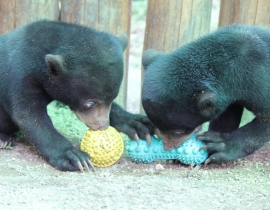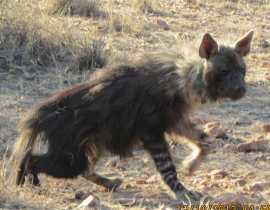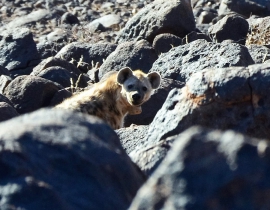Posted April 22, 2014 in All
At the end of last year, we reported on the recent rescue of four sun bear cubs. The first to arrive was a female named Hope. Of the three remaining cubs, male cub 171 was rescued from a market in Kompong Speu province weighing just under 3kg; rescue 172, a slightly bigger female cub, was discovered in Phnom Penh and was extremely bloated, probably down to the poor diet she received from her captors and finally rescue 173 was found tied up in a garden by the side of a road.
These three cubs were rescued back in August and September and have now completed their three-month quarantine period, where they have now achieved their life-long names; rescue 171 was given the name “Jesus”, rescue 172 became “Willow” and rescue 173 became “Maggie”.
The worrying increase in the number of sun bear cubs being rescued and brought into Free the Bears’ care has not let up over the past few months, with another two cubs also joining the growing nursery groups recently. In early December another female Sun bear cub was handed over by a member of the military in Ratanakiri province; named Luna, this cub has already been mixed with Jesus and Willow to form a trio.
The 175th bear to be rescued since the project started in Cambodia was found on the 21st February; the first rescue in 2014. This female Sun bear cub was handed over by a high-ranking official from Mondulkiri province.
Recently there appears to be deluge of cubs originating in the northeastern provinces of Cambodia. Traditionally the provinces of Mondulkiri, Ratanakiri and Stung Treng have been home to vast swathes of forest which in turn were home to many endangered species that had already been driven to extinction in other areas of Southeast Asia. Over the past decade thousands of hectares of forest have been converted for agricultural purposes, with rubber and palm oil being planted on the site of what was once tropical forest. Is it possible that all of the bear cubs being handed over were really found abandoned by their mothers on the forest’s edge, or has the opening up of this area led to a dramatic increase in the number of hunters roaming the forest in search of high value targets such as bears? More research work is desperately needed to understand what forces are driving the increase of bear cubs being rescued, and of course more anti-poaching patrols are needed on the ground in those areas of natural forest that remain.
Picture © Free the Bears



